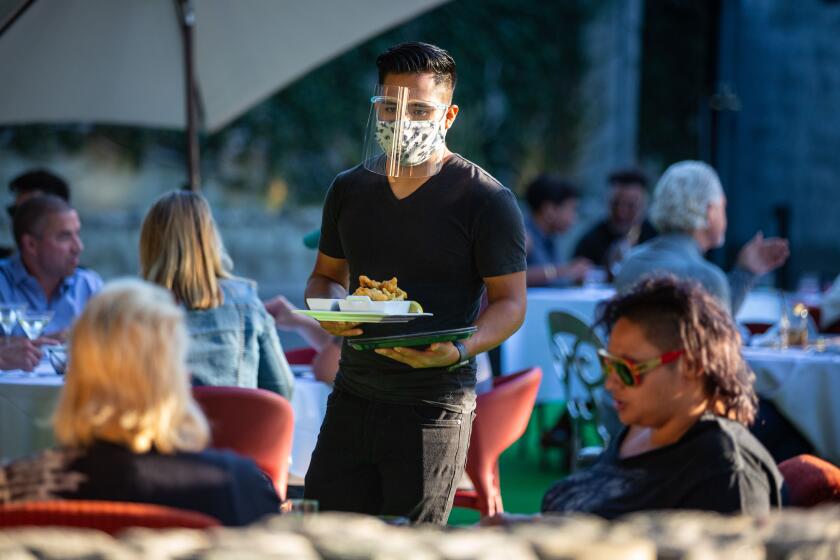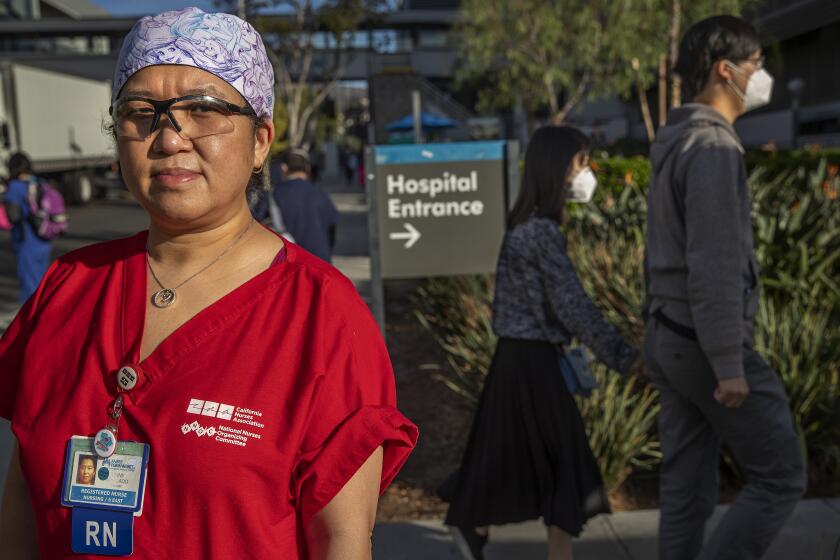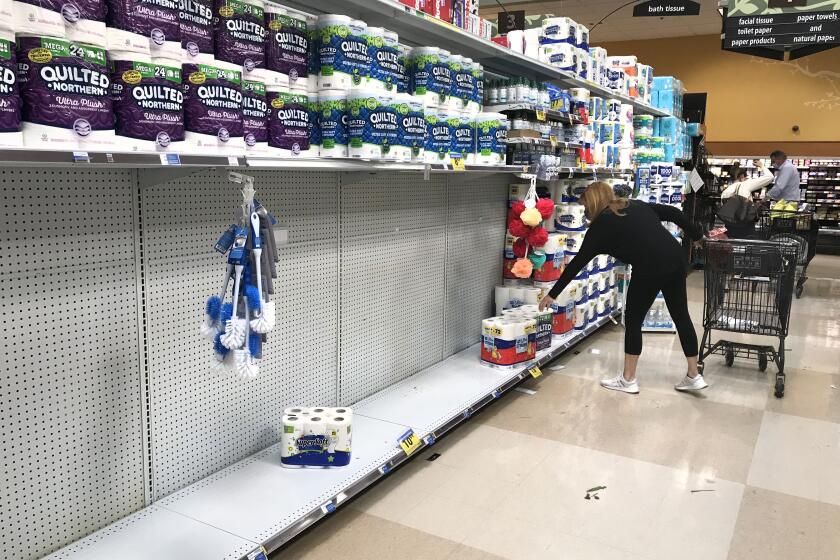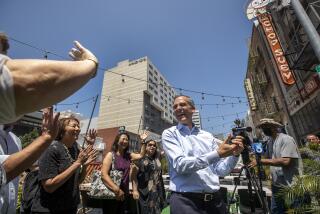L.A. County suspends outdoor dining at restaurants as coronavirus surges

In a devastating blow to Los Angeles’ struggling restaurant and hospitality industry, L.A. County public health officials on Sunday announced they will suspend outdoor dining at restaurants amid a surge of new coronavirus cases.
Few segments of Southern California’s economy have been hit harder by the pandemic than the once-booming dining world, with many landmark establishments closing in recent months and many more on the brink. After they were forced to shut indoor dining rooms in the spring, many eateries got a lifeline when officials allowed them to serve outdoors, often in patio areas and makeshift dining halls set up in parking lots, sidewalks and streets.
Chefs and restaurateurs react to another shutdown of in-person dining amid L.A. County’s coronavirus surge. “We’re holding on for dear life,” one chef said. “There’s no aid in sight, nothing at all.”
The new rule takes effect at 10 p.m. Wednesday and restricts restaurants — along with breweries, wineries and bars — to takeout and delivery only for the first time since May. It will remain in place for at least three weeks, officials said. Wineries and breweries can continue retail operations.
“The persistent high number of cases requires additional safety measures that limit mixing in settings where people are not wearing masks,” Barbara Ferrer, the Los Angeles County public health director, said in a statement.
As expected, restaurateurs greeted the news with frustration and dismay, expressing particular concern for their employees.
“What do I think of it? It’s horrible. It’s another punch,” said Michael Simhai, the owner of Della Terra, an Italian restaurant in the Fairfax district, about 10 minutes after learning of the moratorium on outdoor dining.
“It will be horrible for my staff,” said Simhai, noting that his takeout business would not offset the loss from patrons dining on his restaurant’s patios. “All the busboys, food runners, servers — they are not needed…. They work paycheck to paycheck. What we are going to do?”
Officials had warned last week that the rule would be imposed if the five-day average of new cases hit 4,000, or if hospitalizations topped 1,750 per day.
The five-day average had reached 4,097 by Sunday, the Department of Public Health said, and hospitalizations stood at 1,473 on Saturday, an increase of 92% from a month before.
Officials on Sunday reported 2,718 new cases of the virus and nine deaths, bringing the toll in L.A. County to 364,583 cases and 7,438 deaths.
“While I know our case counts are growing rapidly, I would have rather discussed this measure openly during our Board of Supervisors meeting so that the public could understand the rationale behind it,” county Supervisor Janice Hahn said in a statement.
“Some of these restaurants are barely hanging on. I hope this isn’t the last nail in their coffins,” Hahn said.
Jacob Shaw, an owner of Beaches, a restaurant and lounge on Santa Monica Boulevard in West Hollywood, said he was tracking the rising coronavirus case numbers on the L.A. County website as he girded for another closure.
“It’s not good, but there’s nothing we can do,” said Shaw, who feared the ban on outdoor dining would extend beyond three weeks. “Usually the holidays are a nice little bump for us, but it looks like that’s not going to happen this year.
“Last time we shut down, we had some federal packages at least pending. This time, we don’t know what will happen,” Shaw said. “It’s a little bit scarier.”
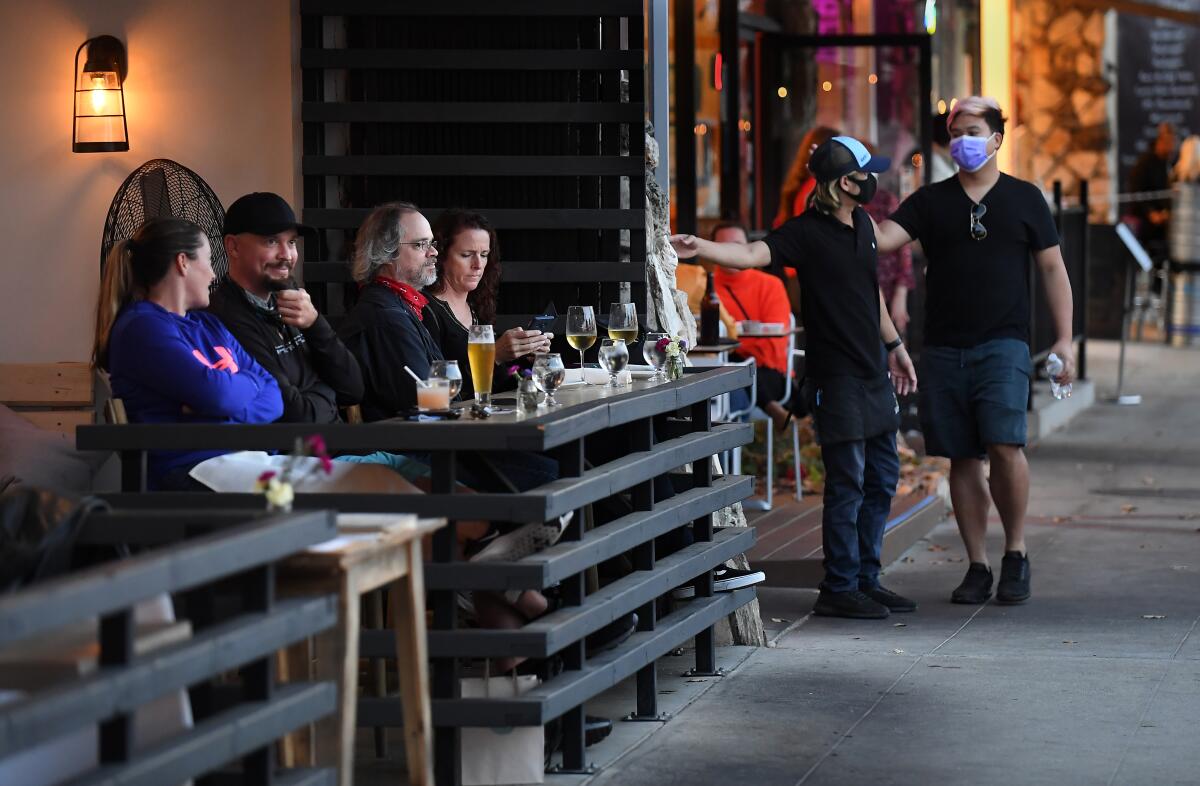
For many restaurateurs and bar owners, the restrictions come just as they have been investing in patio furniture, extra cleaning supplies, heaters and awnings to safely — and comfortably — seat customers outside.
Casa Vega owner Christy Vega Fowler said she spent $30,000 to set up two tents behind her family’s Mexican restaurant in Sherman Oaks. The tent rentals cost an additional $10,000 per month on top of her restaurant’s regular rent.
“They told us we could operate with outdoor dining, we did it safely, we made the investment, and then they take it away from us,” Vega Fowler said. “It’s devastating.”
She said she planned to drastically reduce the hours of many of her employees after running her costs Monday.
Simhai said he had just spent money boarding up Della Terra in case there was postelection unrest, on top of the added costs of outdoor dining equipment.
Gov. Gavin Newsom has announced a stay-at-home order affecting most of California.
“We opened a back patio. We spent money reinforcing it, putting heaters in, thinking that in the holiday season, we’d make money,” said Simhai, who opened his restaurant in 2009. “All that money I spent, I can’t recover it.
“I’m more worried about my staff. After three weeks, who knows? How much more after that? How are they going to pay rent?” Simhai said.
He felt that government officials did not grasp the consequences of the dining shutdown for his business and staff.
“I guarantee the people making these decisions make the same salary regardless of whether there is a shutdown or not,” he said.
A new surge of COVID-19 is battering Southern California, bearing down on exhausted healthcare workers, raising anxiety levels on hospital wards and stoking fears that there might not be enough staff and supplies for the difficult weeks ahead.
Health officials have blamed the rise in new cases — which has been even more rapid than the July peak — on a variety of factors, including holidays, sports championships, protest demonstrations, an increase in both social gatherings and workplace outbreaks and an overall sense of fatigue when it comes to following rules.
Officials have urged residents to stay home as much as possible for the next two to three weeks to curb the rising tide of infections and avoid overwhelming the healthcare system.
L.A. County could face even stricter rules to stem the spread of the virus if the average number of new daily coronavirus cases over a five-day period continues to rise and tops 4,500, or if hospitalizations grow to more than 2,000, officials said.
In that event, officials plan to impose a three-week stay-at-home order that would permit only essential workers and those procuring essential services to leave their homes.
Doug Rankin, chef at Bar Restaurant in Silver Lake, said that outdoor dining had helped the restaurant break even over the last few months, generating enough to carry it through the year and ensure staffers kept their jobs.
Rankin planned to pivot entirely to takeout. He said that the entire service staff had already been laid off and that kitchen staff would be scaled down immediately.
“We’re holding on for dear life,” he said. “It’s frustrating because we’ve done everything that has been asked of us, healthwise. We’ve been on top of it. And now they want to point the finger at restaurants. Where is the data?”
Many in the hospitality industry shared the sense that their businesses were being scapegoated, and they worried that the closure of outdoor dining would push L.A. County residents to gather at homes, where adherence to safety measures would be inconsistent or absent.
“We’ve been operating for many weeks while the number of cases were in decline. Outdoor dining is not the reason the caseloads are going up,” contended Caroline Styne, a restaurateur and sommelier and co-owner of AOC, Tavern and the Larder. “What people are doing at home is the problem.”
Los Angeles County Supervisor Sheila Kuehl said she understands that businesses are already suffering, but she asserted that it was necessary to take a step backward to get a handle on the rising rate of infection.
“The more we opened up, the higher the case rate became,” said Kuehl, whose district includes the Westside, Malibu, and much of the San Fernando Valley. “It’s particularly difficult at restaurants and wineries and breweries because people sit for a long time without masks. And even outdoors, the virus still carries through the air.
“Clearly, as the case rates went up, it was an indicator that everyone was not being compliant,” she added.
Last week, L.A. County announced that nonessential businesses must close at 10 p.m. and further limit their maximum capacity during business hours, and capped the size of outdoor gatherings at 15 people. Such businesses, however, can still offer pickup and delivery services in the late-night hours.
A modified stay-at-home order goes into effect for the much of California as of Saturday morning to try to slow the rapid spread of the coronavirus.
Gov. Gavin Newsom also imposed a modified stay-at-home order that took effect Saturday and remains in place through Dec. 21. The order prohibits most nonessential activity outside the home from 10 p.m. to 5 a.m. in counties that are in the strictest, purple tier of the state’s four-phase color-coded reopening plan. Roughly 94% of the state’s population lives in purple counties, including all of Southern California.
For Shirley Chung, chef-owner of Ms Chi restaurant in Culver City, Sunday’s shutdown on outdoor dining was not unexpected, but has forced her to turn her attention to building more business concepts out of her single restaurant kitchen.
She now sells her mochi doughnuts under the name Mo-Chi Donuts on Grubhub, and with this latest shutdown, she’s thinking about starting another one called Lu Rou Fantastic, focusing on the braised pork belly dish.
“If this stay-at-home order continues, I might do a burger concept or fried food — something easy that I can turn out with quality from the Ms Chi kitchen,” Chung said. “All I can think of is how can I increase my revenue based on one location.”
Times staff writers Rosanna Xia and Garrett Snyder contributed to this report.
More to Read
Sign up for Essential California
The most important California stories and recommendations in your inbox every morning.
You may occasionally receive promotional content from the Los Angeles Times.
